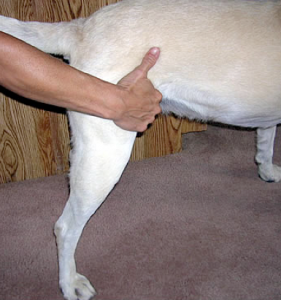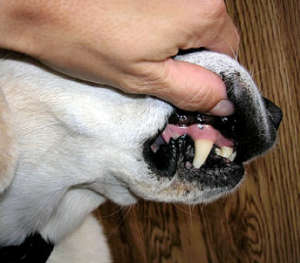Many emergency conditions cause a severe and sudden drop in blood pressure, which triggers shock. Blood loss from internal or external bleeding, severe dehydration, allergic reactions that cause blood pooling in internal organs, toxins, and even intense pain can induce shock.
The body’s first response to falling blood pressure is to increase the heart rate so that more blood can be pumped per minute. Next, the blood vessels that supply the extremities (feet and ears) constrict so that blood is shunted to the interior of the body where it can nourish the vital organs. This is why the feet turn cold. This conservation technique is initially protective, but so much blood can pool in the internal organs that the extremities starve for oxygen.
 There are two important signs of shock that you might notice in a pet at home. The first is a change in pulse. Take your right hand and cup it around the pet’s upper right hind leg so that your fingers rest on the inside surface (check out the picture at right). You can feel the femoral artery coursing down the center of the limb, strongest at the top of the leg. Feel the strength of the pulse and count the number of beats in a minute. During shock, the pulse becomes rapid and weak.
There are two important signs of shock that you might notice in a pet at home. The first is a change in pulse. Take your right hand and cup it around the pet’s upper right hind leg so that your fingers rest on the inside surface (check out the picture at right). You can feel the femoral artery coursing down the center of the limb, strongest at the top of the leg. Feel the strength of the pulse and count the number of beats in a minute. During shock, the pulse becomes rapid and weak.
The second important sign of shock is a pale gum color coupled with a poor capillary refill time (CRT). Lift the pet’s upper lip and check his gum color; it should be a healthy pink. Pale pink or white gums reflect poor circulation. To test CRT, press firmly on the gum with a finger, then release. The blanched or white area that you made should disappear in less than one second. If it takes longer, your friend’s blood pressure is down and shock may be present.
his gum color; it should be a healthy pink. Pale pink or white gums reflect poor circulation. To test CRT, press firmly on the gum with a finger, then release. The blanched or white area that you made should disappear in less than one second. If it takes longer, your friend’s blood pressure is down and shock may be present.
Body temperature also falls during shock (normal is 38.0–39.5 degrees Celsius or 100.5–103 degrees Fahrenheit) and, in later stages weakness and depression develop. Left untreated, severe shock is fatal because the brain and heart muscle don’t get enough blood to function.
The first step in shock treatment is to warm the pet by covering him with blankets. If the pet is outside and it is cold, get your patient into a car and turn the heat up. Once at the hospital, veterinarians treat shock by applying warmth and giving intravenous fluids to boost blood pressure.
Dr. Louise Janes D.V.M. & Dr. Jeff Grognet D.V.M.
 Mid-Isle Veterinary Hospital
Mid-Isle Veterinary Hospital
5-161 Fern Road West
Qualicum Beach, BC
Tel (250) 752-8969
See all articles by Dr. Louise Janes D.V.M. & Dr. Jeff Grognet D.V.M.



